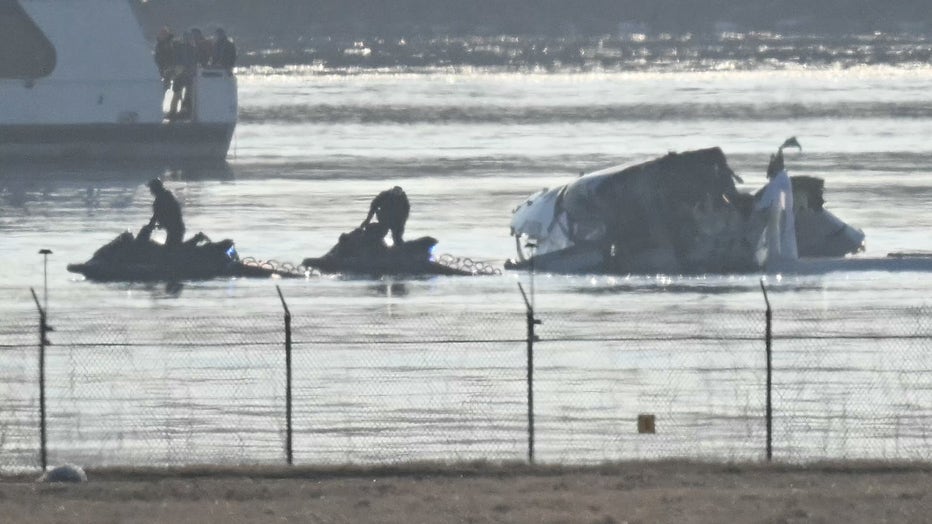DC plane crash: What we know about the aircraft involved
An Army Black Hawk helicopter collided with an American Airlines passenger jet Wednesday night, killing three soldiers, 60 passengers and four crew members on board.
The crash happened while the jet was landing at Ronald Reagan National Airport, sending wreckage into the icy Potomac River. Passengers on the jet, which was coming from Wichita, Kansas, included a group of figure skaters, their coaches and family members who were returning from a development camp held after the national U.S. Figure Skating Championships.
Officials said Thursday that there are no survivors, and at least 28 bodies had been recovered so far.
LIVE DC plane crash updates: 28 bodies recovered; no survivors expected
Here’s what we know about the aircraft involved.
UH-60 Black Hawk Helicopter
DC plane crash updates: Bodies recovered; no survivors expected
Officials say that at least 28 bodies have been recovered from the icy waters of the Potomac River following the collision of an American Airlines jet, carrying 60 passengers and four crew members, with an Army helicopter while landing at Ronald Reagan National Airport near Washington.
The Sikorsky UH-60 Black Hawk is one of the most common military helicopters and performs multiple tasks, including air assault, general support, medevac, command and control, and special operations support, according to Reuters.
RELATED: Air traffic control audio in DC plane crash captures moments around collision
By the numbers:
More than 5,000 Black Hawk helicopters have been built since the 1970s.
The Army Black Hawk involved in the crash was flying with the call sign PAT25 and had three soldiers on board. They were on a training flight when the crash happened. The helicopter is based at Fort Belvoir in Virginia.
U.S. Defense Secretary Pete Hegseth said the crew was "fairly experienced." They were wearing night vision goggles and doing a required annual night evaluation when the crash occurred.
Flying a military helicopter like the Black Hawk requires intense training, as pilots must manage multiple controls simultaneously while navigating difficult terrain.
Retired U.S. Army Lt. Col. Darin Gaub, who flew Black Hawks for 22 years, described it as a "master class in multitasking," requiring split-second decision-making. Pilots operate in high-stress environments, often using night-vision goggles, GPS instruments, and multiple radios while scanning for obstacles, the Associated Press reported.
Former Marine helicopter pilot and aviation professor Mark Miller explained that pilots train extensively to fly both visually and by instruments, preparing them for challenging conditions like poor visibility or distractions—such as the heavy light pollution surrounding Reagan National Airport. "You become very well-versed in these conditions, and training reinforces how to react quickly," he said.
Bombardier CRJ700 jet
The plane involved was a Bombardier CRJ700 owned by American Airlines and operated by its subsidiary, PSA Airlines.

Part of the wreckage is seen as rescue crews search the waters of the Potomac River after a passenger plane on approach to Reagan National Airport crashed into the river after colliding with a US Army helicopter, near Washington, DC, on January 30, 2
By the numbers:
According to the Bombardier CRJ700 brochure, the jet can seat up to 78 people. There are about 260 of the aircraft in service, according to Cirium data obtained by Reuters.
FAA records show the plane involved in the fatal crash was made in 2010 and registered N530EA.
According to Reuters, Bombardier sold its CRJ700 program to a Mitsubishi Heavy Industries subsidiary in 2019. They ended production in 2020.
What caused the crash?
What we know:
A few minutes before the jet was to land, air traffic controllers asked American Airlines Flight 5342 if it could do so on a shorter runway, and the pilots agreed. Controllers cleared the jet to land and flight tracking sites showed the plane adjust its approach to the new runway.
RELATED: DC plane crash victims: What we know so far
Less than 30 seconds before the collision, an air traffic controller asked a helicopter if it had the arriving plane in sight. The controller made another radio call to the helicopter moments later, saying "PAT 25 pass behind the CRJ" — apparently telling the copter to wait for the Bombardier CRJ-701 twin-engine jet to pass. There was no reply. Seconds after that, the aircraft collided.
The plane’s radio transponder stopped transmitting about 2,400 feet (732 meters) short of the runway, roughly over the middle of the Potomac.
RELATED: When was the last major commercial airplane crash?
The body of the plane was found upside-down in three sections in waist-deep water, officials said. The helicopter's wreckage was also found.
The military has previously raised concerns about helicopter safety following a series of Black Hawk training crashes.
Since 2014, at least 12 fatal Black Hawk crashes have killed 47 service members, with some incidents linked to "spatial disorientation"—when pilots struggle to gauge altitude or surroundings. In 2023, the Army implemented additional safety measures after a surge in accidents, including a midair collision during a night training flight near Fort Campbell, Kentucky, that killed nine soldiers.
Army aviation chief of staff Maj. Gen. Walter Rugen emphasized the importance of reinforcing pilots’ awareness of their aircraft’s position relative to the ground. "Training must reinforce that pilots know where they are and where their aircraft is with respect to the ground," Rugen said.
What we don't know:
Federal investigators don’t know exactly what caused the crash, though President Donald Trump and others speculate that it could have been avoided. Investigators will try to piece together the moments before the collision, including any communication between the aircraft and air traffic controllers and a loss of altitude by the jet.
The Source: This report includes information from Reuters, the Associated Press and previous FOX 5 DC reporting.

